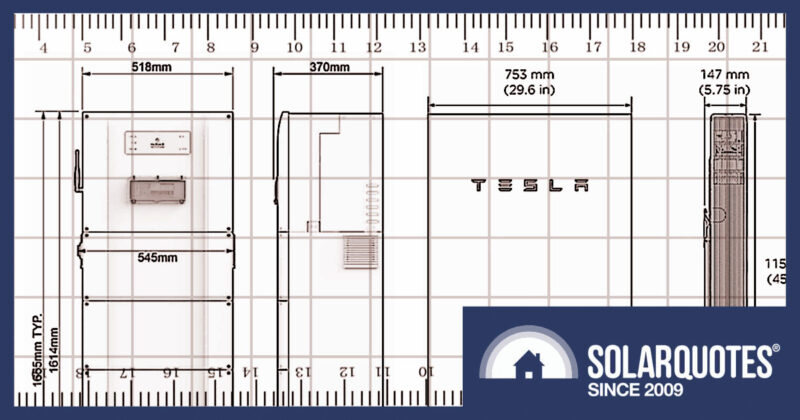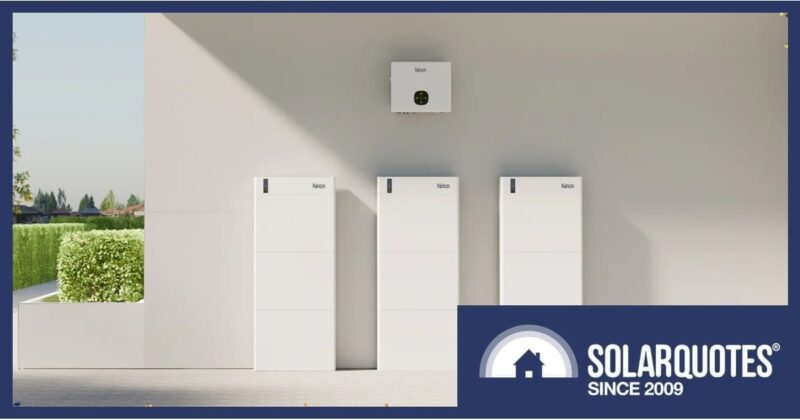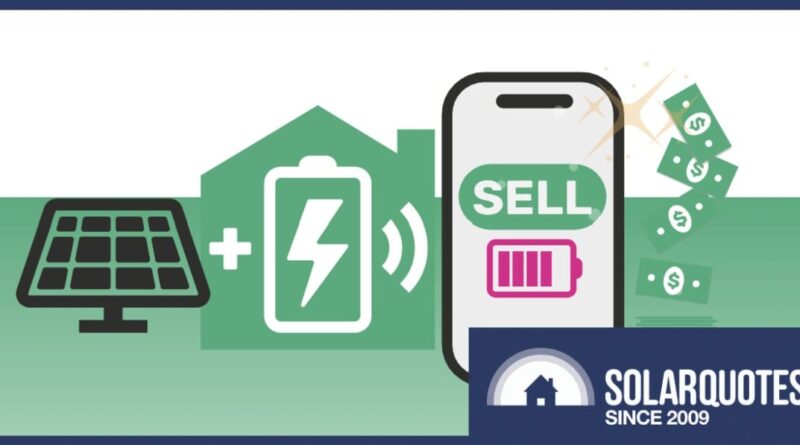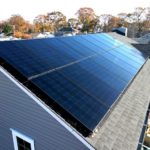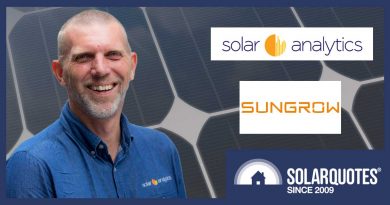GloBird Zerohero: Finally, A VPP That Lets You Control Your Battery
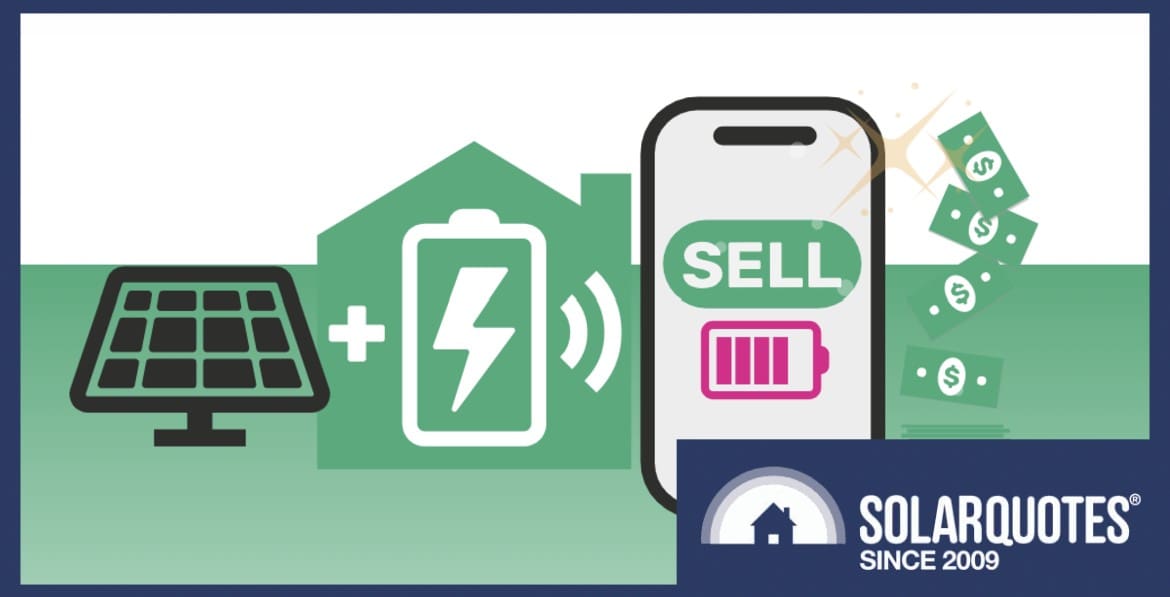
Image: GloBird
I’ve looked into the pros and cons of a range of Virtual Power Plants, and so far, I haven’t been impressed. But GloBird Energy’s Zerohero VPP stands out as the best of a bad bunch. Rather than providing inadequately meagre payments — so long as you have a suitable battery and electricity consumption patterns — its payments have the potential to be adequately meagre.
Another advantage is you’re always in charge of discharging the battery to the grid. Globird will never drain your battery without permission. This is important because one thing widely disliked about VPPs is having to hand over control of the battery you paid for to a faceless organisation — or worse — one with Elon Musk’s face.
The GloBird Zerohero VPP can be particularly useful for homes with smaller solar systems because it provides three hours of free electricity in the middle of the day and this can be used to charge your battery. But because its solar feed-in tariff isn’t great, it may not suit homes with large solar systems that normally export a lot during the day.
I’ll give details below, but you can go to GloBird’s Zerohero page and also check out its terms and conditions if you’d like information straight from the horse’s esophagus. Because it compares well to the competition — take a look at our recently updated VPP comparison table to check for yourself — if you’re looking to join a VPP you may want to give Globird Zerohero a go, provided it’s available in your area.
How To Join
The Globird Zerohero VPP is available in NSW, SA, SE QLD’s Energex area, and VIC. That’s potentially 21.5 million Australians out of 27 million, which isn’t bad.
If you’re a renter, you can join the VPP, but your home will need a suitable solar and battery system.
To join Zerohero you will need:
- A solar system of 3–15kW;
- A home battery with 3–35kWh of storage capacity that is an AlphaESS, Redback, SolaX, Sungrow, Sigenergy, or Tesla Powerwall;
- The battery’s continuous power output must be 3–15kW;
- A reliable internet connection.
No additional hardware is required, as the above battery systems are good to go. But GloBird says you may need to give them the battery’s serial number.
What You Get
There are four ways you can get money out of Zerohero. Three incentives have stupid “zero” names, and they forgot to come up with a silly term for the fourth one:
- Free midday electricity (Zerocharge): Grid electricity is free for 3 hours a day between 11am–2pm. This includes charging your battery. The exception is anything that’s on a controlled load because they are separately metered.
- $1 For zero grid electricity use during a 2 hour evening peak (Zerohero): In QLD this 2 hour peak is between 5pm-7pm. Everywhere else it’s either 5pm-7pm or 6pm-8pm during daylight savings time.
- 15c feed-in tariff for first 10kWh exported during the 2 hour evening peak (Zerowastedsolar): In winter these peak period exports would have to come from your battery, but in summer some could come from solar.
- $1 per kWh exported to grid during critical peaks (Zero stupid name): Globird can designate certain periods as “critical peaks” and will pay $1 for every kWh exported to the grid during these times. These critical peaks will happen when wholesale electricity prices are expected to be exceptionally high, but Globird gives no information on how often they’ll occur. They could be once in a blue moon or once in a big round whitish grey moon — which would be once a month.
Here’s a graphic showing when the three daily benefits occur — outside of daylight savings:
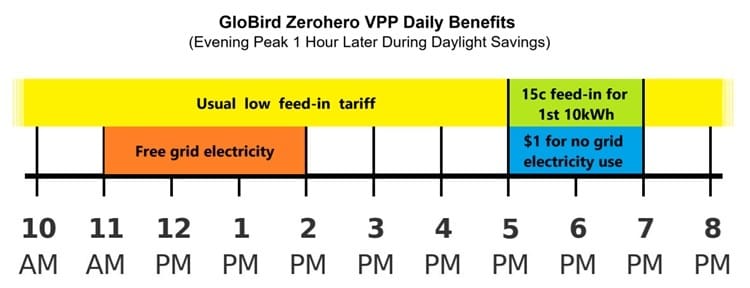
A feed-in tariff is available 24 hours a day, but unless you discharge your battery to the grid you won’t be getting anything at night.
I knocked the above image together this morning because I couldn’t sleep. Despite using ancient software, it still looks better than the horrible graphic GloBird has on their page, which looks like two bacteria exchanging DNA or something.
I hope GloBird steals this.
Low Normal Feed-in Tariff
A problem with many VPPs is their normal solar feed-in tariff usually isn’t great. If I said Zerohero is an exception, that would be a complete lie. It varies by location but can be painfully low. This won’t be a big problem if you have a smaller solar system that often struggles to keep your battery charged, because you won’t export much anyway. But if you have a big solar system — or it’s just medium-sized and there’s no one home during the day — missing out on a higher feed-in tariff could cost you hundreds of dollars per year.
In most locations, the feed-in tariffs are pretty straightforward. There’s a high 15c feed-in tariff for the first 10kWh exported during the two-hour Zerohero evening peak and a low feed-in tariff for exports at all other times. But in Victoria, it’s more complex as the feed-in tariff varies by time of day:
- NSW solar feed-in tariff: 4c
- SA solar feed-in tariff: 1.5c
- SE QLD Energex area solar feed-in tariff: 3c
- VIC solar feed-in tariff: Shoulder 9pm-10am 4.1c, Off-peak 10am-2pm 2.1c, Peak 4pm-9pm 9c
In Victoria, the average feed-in tariff will depend on which direction your solar panels face, with west being best. But for most homes, it’s likely to average out to roughly 3c.
The solar feed-in tariffs offered aren’t great, but aren’t terrible — except in SA where the 1.5c is simply lousy. If you have a large solar system in Adelaide, then Globird VPP is probably not for you.
How Much Will A Low Feed-in Tariff Cost Me?
If you have a 10kW solar system generating an average of 40kWh of clean solar electricity per day and you export half of that to the grid, then if you can get a solar feed-in tariff that’s 3 cents higher than what Zerohero offers, you’d receive $219 more feed-in tariff per year. On the other hand you’d miss out on the benefits, so you’ll have to weigh up the pros and cons.
Grid Electricity Charges Aren’t Bad
What you pay for grid electricity on Zerohero is reasonable compared to what other retailers offer. But if you have solar and a battery — and you get to charge that battery for free in the middle of the day if necessary — then you shouldn’t need to buy much grid electricity. This means, whether the grid rate is high or low, it shouldn’t make much difference for many users. But if you expect to use a significant amount of grid electricity, you’ll need to take its cost into account.
Here’s what you’ll pay in the different locations. Victoria is more complex than the others, as it has an evening peak rate for grid electricity that is different from the two-hour Zerohero peak:
- NSW — Daily supply charge: 96.8c, Per kWh charge: 26.73c for first 760kWh per month, then 29.81c
- SA — Daily supply charge: 125.4c, Per kWh charge: 34.65c for first 760 per month then 37.4c
- SE QLD Peak — Daily supply charge 99c, Per kWh charge: 25.74c for first 760kWh per month then 28.27c
- VIC — Daily supply charge: 102.3c, Per kWh charge: 22c but the Peak rate from 3pm-9pm is 35.2c
In NSW, SA, and SE QLD you pay more after the first 760kWh used in a month, but that averages out to 25kWh per day, so very few people with solar and a battery will use enough grid electricity to pay the higher amount.
$1 For *Almost* No Grid Usage In 2 Hour Evening Peak
If you use no grid electricity during the two-hour Zerohero evening peak you get paid $1. I say no grid electricity, but you’re actually allowed to use up to 0.3kWh. This is important because home batteries usually won’t discharge until the home is drawing around 100 watts or more. So you’ll usually use around 0.2kWh over a two-hour period even if never draw more power than your battery can supply.
Being allowed to use up to 0.3kWh of grid electricity gives a little wriggle room if you briefly draw more power than your battery can provide — but I don’t recommend relying on it.
How Realistic Is No Grid Power For 2 Hours?
Most home batteries provide 5kw of continuous power, which means most battery households will have no problem not using grid electricity for two hours in the evening. Especially if you’ve taken the sensible step of shifting loads such as electric hot water systems to the free period in the middle of the day. Heating or cooling your home to a comfortable temperature before the start of the peak period is also an option.
But let me tell you, if you have an electric stove and my father is cooking for you during the Zerohero peak, you’re not getting your $1. Not with a battery that has a power output of 5kW. He’ll use every hotplate, turn on the oven, plug in an electric wok and an electric frypan, run the microwave, and leave your fridge door open. Even if you have something like a Tesla Powerwall 3 that can provide a continuous 10kW of power he’ll probably find a way to exceed it. It’s not intentional, he’s just cursed1 when it comes to electricity consumption.
You probably already have a good idea if your household is likely to collect those daily $1 bonuses. To improve your odds, you may be tempted to set your battery so it only starts to discharge one minute before the Zerohero peak begins. But this could end up costing you money if it causes you to use grid electricity before the start of the peak and you end up with unused energy in your battery once it starts charging from solar the next morning.
You can also set the battery to discharge during the evening peak to get a 15c feed-in tariff for the first 10kWh exported. But you’ll want to make sure you leave enough energy in the battery to meet your late-night and early-morning electricity use. This is because you’ll always save more money using battery energy to avoid grid electricity consumption than discharging it to the grid for 15c.
You Are In Control Of Discharging — But Will You?
The GloBird VPP doesn’t have control over your battery and can’t discharge it to the grid. You’re in charge of discharge. For this reason, you can argue Globird Zerohero isn’t actually a VPP and is simply a retail electricity plan for battery homes. But I say it’s a VPP and since I just voted myself VPP President, what I say goes. If you disagree with me, as far as I’m concerned, you can go jump in the Gulf of Virtual Power Plant.
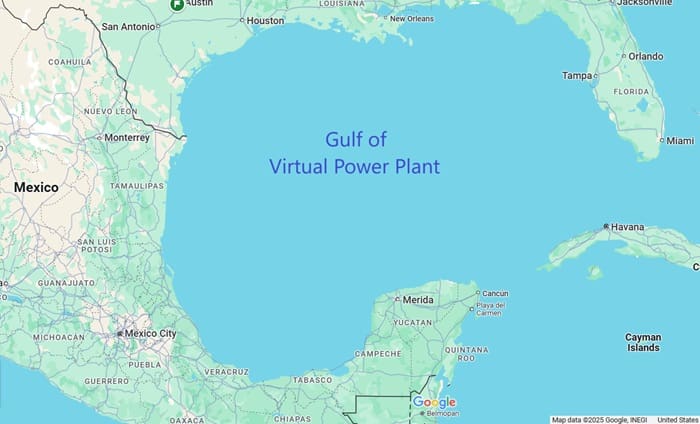

The drawback of being in complete control of your battery is that if you want to make money from discharging it, you have to actually get around to doing it. GloBird helps out by providing information on how to set your battery to discharge automatically. But if you want to take advantage of the higher $1 per kWh payments for discharging during critical peaks, you’ll have to set that manually each time.
Some people will be happy to do this. But a lot of people simply won’t get around to it. You probably have a good idea which type of person you are. But, even if you never discharge to the grid, it can still be worthwhile to join Zerohero.
No Lock-in — You Can Leave Anytime
GloBird Zerohero doesn’t lock you in with a contract, so you’re free to leave anytime you like. The drawback is Globird is free to change their terms & conditions anytime and apply them soon after informing you. This means there’s no guarantee that benefits won’t be reduced in the future.
How Useful Is 3 Hours Free Electricity?
Three hours of free grid electricity from 11am-2pm is handy to have. You can set your battery to charge from both solar and the grid during the free period and also set electric hot water systems and other appliances to switch on at this time. If you often have an EV that’s parked at home in the middle of the day, you may never pay to charge it for normal day-to-day use again.
But you may not save as much money as you think. If you have a decent-sized solar system, then most days you should be using no grid electricity in the middle of the day anyway. The greatest benefit will be for people with smaller solar systems who can have trouble fully charging their batteries in winter or periods of cloudy weather.
You can join the Zerohero VPP with just 3kW of solar. This makes it great for those with limited roof space. But if you have a big roof, I don’t recommend installing a small solar system and then hoping you can join a VPP like Zerohero that can make up for it. Larger solar systems don’t cost a lot more and you’re in a much stronger position if you’re producing plenty of your own clean energy. This is especially true if there’s a grid failure and you have to rely on only your solar and battery.
But watch out for controlled loads. Because they’re metered separately, you still have to pay for their electricity use during the free period. If you’re going on Zerohero it’s probably best to get rid of controlled loads, even if the appliance needs to run for more than three hours a day.
If you’re determined to work out how much you might save and you have a smart meter, you can get your retailer to send you a file of your past electricity consumption, broken down by time. (You can also use this file in our Battery Calculator to estimate the savings from getting a battery.) Alternatively, you could just read your meter around 11am and 2pm for a while to get an idea of how much grid electricity you use in the middle of the day. This is your only real option if you don’t have a smart meter, but note you will need one to join a VPP.
Having a period of free electricity is good, but if you have a larger solar system and don’t have an EV parked at home during the day, it won’t save you a lot of money. For many solar households, it’s likely to average around a dollar or less per week.
How Much Can You Save?
Provided the plan suits you, the total you can earn from Zerohero can add up to a decent amount compared to other VPPs. However, I’m not including electricity plans that let you buy and sell electricity at wholesale prices, such as Amber, in this comparison. While they could let you make more money, because you can also lose money, I only recommend them for people who know what they’re doing and have the right battery setup. Zerohero is a less stressful way to — hopefully — make some money without ever discharging your battery to the grid if you don’t want to.
If you’re able to consistently avoid using grid electricity during the two-hour Zerohero peak then your $1 payment will mount up. If you can pull it off on average for six days a week, then that will come to over $300 per year.
Having three hours of free electricity in the middle of the day also lets you save money. For homes with small solar systems it could be hundreds of dollars annually, but not much at all for homes with large solar systems. If you have a 6.6kW solar system you’re not likely to save a lot and if you have a 10kW system you’ll tend to save even less.
If you do discharge your battery to the grid, you can make some extra money, but I wouldn’t count on making much.
It will only make sense to discharge to the grid during the Zerohero peak to chase the 15c per kWh for the first 10kWh if you regularly fail to consume all the energy in your battery overnight, as you save more than 15c by using your stored energy to avoid using grid electricity. Some may not even consider the extra wear and tear on their battery to be worth 15c.
There are payments of $1 per kWh discharged to the grid during critical peaks, but it’s not known how often these will occur, so they can’t be relied on. You’ll also need to be motivated enough to set your battery to take advantage of them once you receive a notification. Because discharging your battery during a critical peak is likely to increase your grid electricity consumption, what you actually make will normally average less than $1 per kWh. While you may be able to make a lot more than $30 per year from discharging during critical peaks, I’d say don’t count on making more until we get good information from GloBird on how often they occur.
On the downside, you will receive a lower solar feed-in tariff than what’s available with a non-VPP electricity plan. If you have a large solar system this could make Zerohero a big zero.
More Pro Than Con For Most
Whether or not it makes sense for you to join the GloBird Zerohero VPP will come down to weighing up the cost and benefits. But even if all you do is get $1 six days a week from not using grid electricity during the Zerohero evening peak, you’ll still come out ahead of most VPPs that we’ve compared.
So while I’m not yet ready to give any VPP my seal of approval, I am happy to give GloBird Zerohero my seal of mild optimism that it’s the best VPP option currently available for many households.
Footnotes
Original Source: https://www.solarquotes.com.au/blog/globird-zerohero-finally-a-vpp-that-lets-you-control-your-battery/
